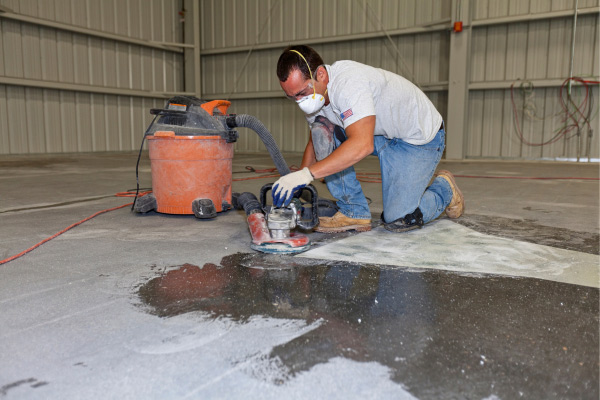Can you sand concrete? The answer is yes. You may want to sand it for a variety of reasons, including to smooth out the finish, expose the aggregate rock, smooth some rough spots or imperfections, or because you are making a repair.
Sanding concrete isn’t difficult if you have the right tools. This article will help you select the right one, as well as walk you through the process of how to sand concrete.
How to sand concrete
- Select the right tool
There are a variety of tools that you can use to sand concrete. The best tool for your project will depend on the size of the area you want to sand and its accessibility. Here’s a short list of tools with their best applications:
- Handheld diamond sandpaper or polishing pads can be used on small projects like crack repairs.
- A handheld concrete sander or orbital sander is best for indoor projects like bathroom floors or countertops.
- Belt sanders are great for larger projects like garage floors.
- For large outdoor spaces like patios or driveways use a floor concrete grinder or walk-behind grinder.
2. Prepare the right surface
Prepare the surface you’ll be sanding by filling cracks or holes, chiseling away bumps, and removing dust and debris.
3. Think safety
Be sure to wear the appropriate personal protective equipment (PPE), including goggles to protect your eyes from dust and a dust mask or respirator. Use equipment that has water or a vacuum attached to reduce airborne dust.
4. Sand the desired area
Run the sander over the area. Be sure to follow the equipment instructions for the best results, and start out with a coarser grit of sandpaper, moving on to a finer grit with each pass.
5. Clean the surface
Remove remaining dust or debris by vacuuming and/or wiping the surface with a wet sponge.
6. Repeat the sanding process
If the surface needs more sanding or a smoother finish, repeat the process of sanding and cleaning until you get the desired results.
7. Protect the surface
Finally, apply a protective coating to ensure the longevity of the finished product. A concrete sealant will protect it from wear, tear, stains, and spills.
Tips and Tricks
- Use only concrete polishing pads or diamond sandpaper for sanding concrete. Regular sandpaper isn’t strong enough for this type of work.
- Start with a coarse sandpaper, usually 30 to 60 grit. Make multiple passes with increasingly fine sandpaper. A 200 to 400 grit paper will provide the smoothest finish.
- Wet the concrete before you start sanding to reduce dust. Use a tool with a water hose or vacuum attached to catch or dampen dust while you’re working. If this isn’t feasible, be sure to wear a proper face mask or respirator.
- Sanding doesn’t weaken the concrete as you are only removing a small amount of material.
- Before sealing, wash the surface thoroughly: vacuum or sweep away debris, rinse with soapy water, then allow it to fully dry, which may take up to two days.
- There are four types of concrete sealers:
- Penetrating sealers penetrate into the concrete and react chemically with it to protect it from moisture penetration and chemicals.
- Acrylic sealers provide a thin protective film on the concrete’s surface.
- Polyurethane sealers provide a thicker protective film than acrylics.
- Epoxies provide an even thicker protective film than polyurethanes.
Sanding concrete is a great way to revitalize a surface or remove imperfections. The key is to use the right tool and sandpaper for the job.





